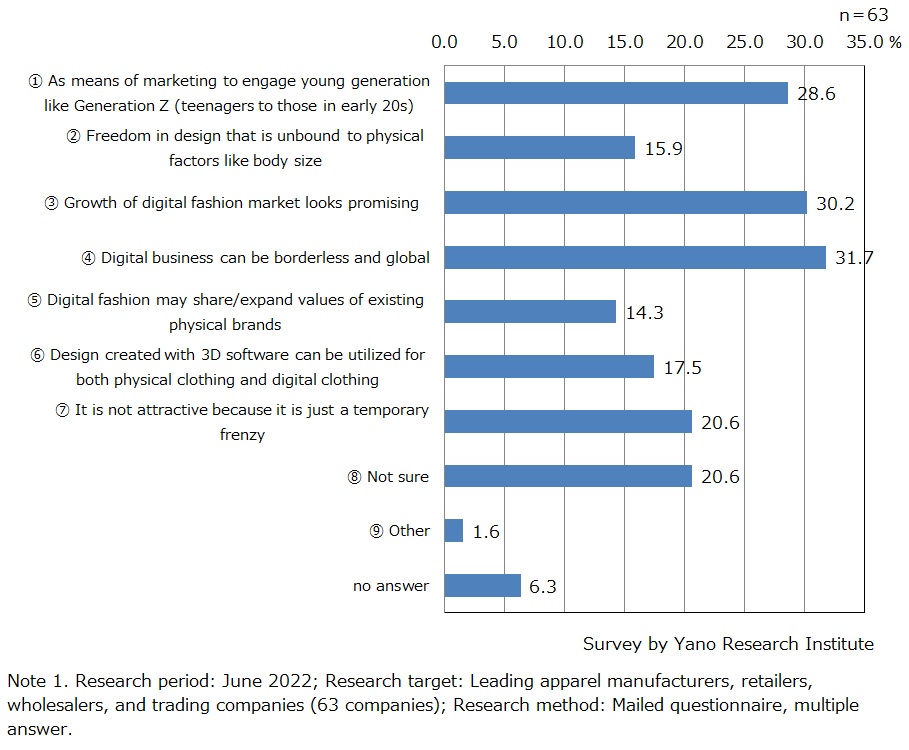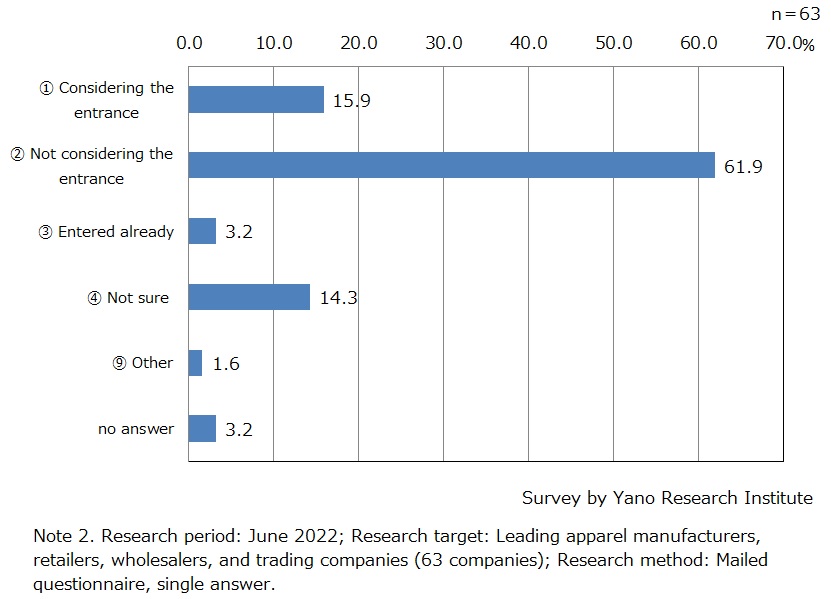No.3079
Corporate Questionnaire to Apparel Industry in Japan on Current Status and Challenges in Digital Fashion: Key Research Findings 2022
Corporate Questionnaire Reveals Only A Fraction of Apparel Companies Has Entered Digital Fashion Business
Yano Research Institute (the President, Takashi Mizukoshi) has carried out a corporate questionnaire to Japanese apparel industry regarding digital fashion*1, and found out the current status and challenges in their business in the metaverse (virtual space) and NFT*2. This press release shares some of the analysis results.
*1: Digital fashion refers to the virtual clothing designed for avatars in the metaverse. It is used as an antonym of ‘physical’ fashion, the clothes wearable for real human.
*2: NFT is short for Non-Fungible Token, a unique digital identifier used to certify authenticity and ownership of digital assets that is recorded in a blockchain. It is mostly used in the content business, for instance, digital trading cards for game characters and athletes, and digital art.


Summary of Research Findings
In June 2022, Yano Research Institute sent a corporate questionnaire to 63 businesses in the domestic apparel industry (manufacturers, retailers, wholesalers, and trading companies) to find out their current status and challenges they face in digital fashion, which has been highlighted internationally, particularly regarding their attempts in the metaverse (virtual space online) and NFT.
To a question asking in what aspect the metaverse and NFT attract them (multiple answers), many companies chose “digital business can be borderless and global” (37.1%) and/or “growth of digital fashion market looks promising” (30.2%), indicating their hopefulness towards digital business. Some respondents selected “design created with 3D software can be utilized for both physical clothing and digital clothing” (17.5%), which points out the benefit of introducing 3D CAD technologies (such as 3D modelling software). Meanwhile, a certain proportion of respondents showed reluctance towards digital fashion, saying “(it is not attractive because) it is just a temporary frenzy” (20.6%).
The survey also revealed that only 3.2% of the leading domestic apparel companies are currently in the metaverse and/or NFT business. A little less than 20% said they are “considering the market entrance” (15.9%), and more than 60% are “not considering the market entrance” (61.9%).
In summary, despite the attraction of metaverse and NFT business, only a fraction of apparel companies is involved at present. More than 60% of the companies are not even considering the entrance to the market.
Noteworthy Topics
Background of Emergence of Digital Clothing for Avatars in the Metaverse
Apparel industry is said to be falling behind in digital transformation when compared with other industries. The delay is due to the complexity of supply chain, which makes it difficult to consolidate data from design (starting point) to sales (end point).
Besides, as a result of business model that pursue mass production and mass consumption based on demand prediction, the industry has been overproducing, creating unthinkable quantities of unsold garments ending up on landfill or incineration. The industry is condemned for being unsustainable.
Amidst the global trend of sustainability, apparel industry is expected to increase precision in demand forecast by lean production. In this sense, digital transformation and sustainable actions are directly connected.
While digitization has advanced in product management (inventory management) and sales (sales management, sales promotion, and marketing) of finished goods, it fell behind in planning and designing. However, apparel companies are increasingly streamlining production of conventional clothing (‘physical’ clothes) by deploying 3D CAD to reduce sample creation process and shorten lead time. Meanwhile, the 3D data in planning and designing can also be used for digital clothing. 3D technology is expected as an enabler of “double cropping” * for fashion manufacturers and brand designers that are facing predicaments in generating a new revenue stream.
The advantage of digital fashion is liew in the fact that it is digital data on the metaverse. Cost of reaching customers around the world is considerably lower for digital fashion compared with that of conventional ‘physical’ garments. In line with the growth of global enthusiasm for the metaverse, apparel companies and surrounding industries are focusing on digital fashion and counting on its future.
*The expression “double cropping” here refers to the state where apparel industry generates two revenue streams using 3D modeling software, by streamlining production of physical garments and by designing digital fashion (virtual clothing for avatars).
Research Outline
2.Research Object: Leading apparel manufacturers, retailers, wholesalers, and trading companies in Japan (a total of 63 companies)
3.Research Methogology: Mailed questionnaire
Corporate Questionnaire to Japanese Apparel Companies on Current Status and Challenges in Digital Fashion
The corporate questionnaire was carried out in June 2022 to 63 businesses of apparel industry, including leading apparel manufacturers, retailers, wholesalers, and trading companies. An objective of the survey is to find out the current status and challenges of Japanese apparel companies regarding digital fashion business ( virtual 3D clothing designed for avatars), particularly in relation to the metaverse (virtual space online) and NFT (Non-Fungible Token, a unique digital identifier used to certify authenticity and ownership of digital assets that is recorded in a blockchain).
Published Report
Contact Us
The copyright and all other rights pertaining to this report belong to Yano Research Institute.
Please contact our PR team when quoting the report contents for the purpose other than media coverage.
Depending on the purpose of using our report, we may ask you to present your sentences for confirmation beforehand.